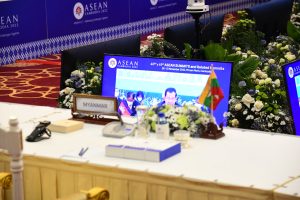The head of Myanmar’s military junta met yesterday with the newly appointed special envoy from the Association of Southeast Asian Nations (ASEAN), state media reported, as the military continued to suffer losses in the country’s west and northeast.
According to a report today in the Global New Light of Myanmar, Senior Gen. Min Aung Hlaing, the head of the military State Administration Council (SAC), met Alounkeo Kittikhoun in the plush, gilded surrounds of his office in Naypyidaw.
During the meeting, the two leaders discussed “efforts of the government to ensure peace and stability of the State and national reconciliation,” the newspaper reported. Min Aung Hlaing said his administration is “implementing the ASEAN Five-Point Consensus adjusted with the roadmap of the State Administration Council,” it added.
Alounkeo also met with the junta’s foreign minister, Than Swe, and representatives of seven junta-friendly ethnic armed groups, where similar topics were discussed.
Alounkeo, a veteran Lao diplomat, who has served as the country’s deputy foreign minister, was appointed ASEAN’s special envoy on Myanmar by current chair Laos at the start of this month. In this capacity, he is responsible for pushing the military administration to implement the bloc’s Five-Point Consensus, which calls for an immediate cessation of hostilities and inclusive dialogue involving “all parties” to the conflict that has followed the military’s disastrous coup d’etat in February 2021.
However, since the Consensus was established in April 2021, the SAC has done virtually nothing to implement its terms. Instead, it has prioritized the delusional “roadmap” referenced by Min Aung Hlaing, which envisions the pacification of the country followed by tightly delimited “elections” and a transition of power back to a “civilian” government. In practice, most observers suspect that this plan amounts to the entrenchment of military control behind a civilianized façade.
Previously, Min Aung Hlaing has informed visiting ASEAN envoys that he will implement ASEAN’s peace plan only after the completion of his own roadmap. In this context, yesterday’s pledge to “adjust” the Five-Point Consensus to the SAC’s own plans does not seem like a significant shift in position. Indeed, Min Aung Hlaing seems to be signaling once again that outright victory on the battlefield, or a compromise peace on the military’s terms, are the only outcomes that he is willing to countenance.
This is notable, given the significant military reversals that the SAC has suffered in northern Shan State since late October, when an alliance of ethnic resistance groups launched a broad offensive that it dubbed Operation 1027. According to an analysis published in November by the International Institute for Strategic Studies, Operation 1027 has “presented the Myanmar armed forces with their most serious battlefield challenge in at least 30 years.” Rebel forces have made many more gains in the two months since.
The fact that Min Aung Hlaing is holding fast to his own “roadmap” suggests that the battlefield reversals have not pushed him fundamentally to reconsider his goals. This raises the question of whether ASEAN mediation might look more attractive if the junta’s military fortunes continue to deteriorate.
This was suggested by Hunter Marston in an article for 9DASHLINE this week. “Given its cascading failures on the battlefield, inability to stem financial freefall, or garner even a glimmer of popular support among a defiant population,” he wrote, “Myanmar’s junta may feel compelled to re-examine the terms” of the Five-Point Consensus.
After more or less ignoring ASEAN’s calls for moderation and restraint, Marston concluded, “it might just be the body that Myanmar’s generals look to when they see their options run out.”
This is possible – though whether an ascendant resistance, driven by a bone-deep hatred for the military and the atrocities it has committed over the past three years, would be willing to take part in ASEAN-brokered talks is another question.
Here, once again, we encounter the contradiction between ASEAN’s view of the conflict, which presumes at least the potential for good faith dialogue, and the current view of the two sides, who have come to see the war as a zero-sum struggle for the nation’s future.

































